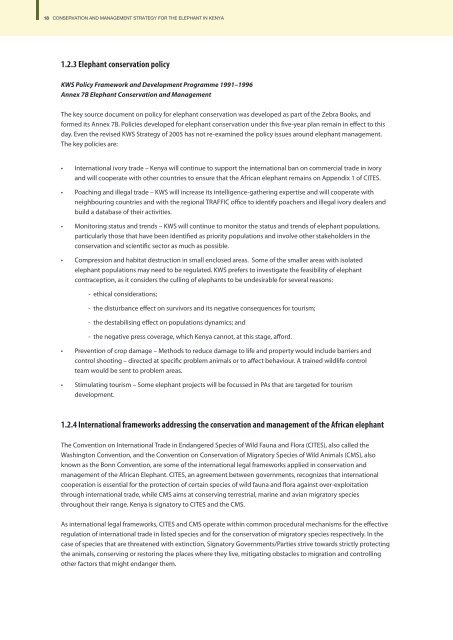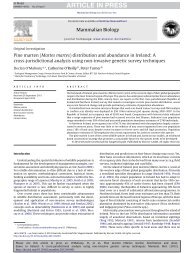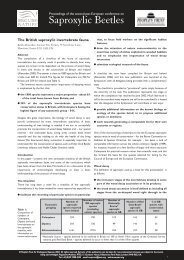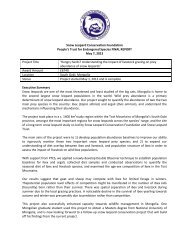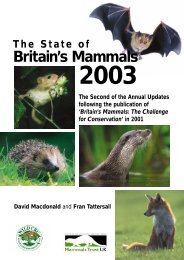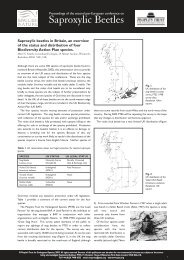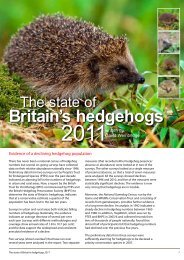National Elephant Strategy - People's Trust for Endangered Species
National Elephant Strategy - People's Trust for Endangered Species
National Elephant Strategy - People's Trust for Endangered Species
Create successful ePaper yourself
Turn your PDF publications into a flip-book with our unique Google optimized e-Paper software.
18 CONSERVATION AND MANAGEMENT STRATEGY FOR THE ELEPHANT IN KENYACONSERVATION AND MANAGEMENT STRATEGY FOR THE ELEPHANT IN KENYA 191.2.3 <strong>Elephant</strong> conservation policyKWS Policy Framework and Development Programme 1991–1996Annex 7B <strong>Elephant</strong> Conservation and ManagementThe key source document on policy <strong>for</strong> elephant conservation was developed as part of the Zebra Books, and<strong>for</strong>med its Annex 7B. Policies developed <strong>for</strong> elephant conservation under this five-year plan remain in effect to thisday. Even the revised KWS <strong>Strategy</strong> of 2005 has not re-examined the policy issues around elephant management.The key policies are:• International ivory trade – Kenya will continue to support the international ban on commercial trade in ivoryand will cooperate with other countries to ensure that the African elephant remains on Appendix 1 of CITES.• Poaching and illegal trade – KWS will increase its intelligence-gathering expertise and will cooperate withneighbouring countries and with the regional TRAFFIC office to identify poachers and illegal ivory dealers andbuild a database of their activities.Kenya’s population of African elephant is listed in Appendix I of CITES and Appendix II of CMS. Under CITES AppendixI, species are threatened with extinction, which are or may be affected by trade while Under Appendix II of the CMSspecies are migratory that need, or would significantly benefit from, international cooperation.Kenya Wildlife Service is mandated under Section 3A J. of the Wildlife Act to be the lead agency <strong>for</strong> theimplementation of the Conventions as guided by the Act and other provisions such as the Sessional Paper No.3 of1975 Policy on future wildlife management of Kenya; Revocation of wildlife hunting (1977); Revocation of dealershipin wildlife products (1978); EMCA (1999); Forest Act CAP 385; Fisheries Act cap 378 and other biodiversity relatedConventions, Treaties, Protocols and Agreements.The <strong>National</strong> <strong>Elephant</strong> <strong>Strategy</strong> has been developed reflecting on the provisions of CITES and CMS as keyinternational legal frameworks that cover conservation and management of the African elephant nationally andglobally and by which Kenya has committed to abide.• Monitoring status and trends – KWS will continue to monitor the status and trends of elephant populations,particularly those that have been identified as priority populations and involve other stakeholders in theconservation and scientific sector as much as possible.• Compression and habitat destruction in small enclosed areas. Some of the smaller areas with isolatedelephant populations may need to be regulated. KWS prefers to investigate the feasibility of elephantcontraception, as it considers the culling of elephants to be undesirable <strong>for</strong> several reasons:- ethical considerations;- the disturbance effect on survivors and its negative consequences <strong>for</strong> tourism;- the destabilising effect on populations dynamics; and[ LEFT ] Plate 19.<strong>Elephant</strong>s being translocated from Ngulia Rhino Sanctuary into the widerTsavo West <strong>National</strong> Park. On the back is the identification number toassist in post release monitoring - Richard Kock- the negative press coverage, which Kenya cannot, at this stage, af<strong>for</strong>d.• Prevention of crop damage – Methods to reduce damage to life and property would include barriers andcontrol shooting – directed at specific problem animals or to affect behaviour. A trained wildlife controlteam would be sent to problem areas.• Stimulating tourism – Some elephant projects will be focussed in PAs that are targeted <strong>for</strong> tourismdevelopment.1.2.4 International frameworks addressing the conservation and management of the African elephantThe Convention on International Trade in <strong>Endangered</strong> <strong>Species</strong> of Wild Fauna and Flora (CITES), also called theWashington Convention, and the Convention on Conservation of Migratory <strong>Species</strong> of Wild Animals (CMS), alsoknown as the Bonn Convention, are some of the international legal frameworks applied in conservation andmanagement of the African <strong>Elephant</strong>. CITES, an agreement between governments, recognizes that internationalcooperation is essential <strong>for</strong> the protection of certain species of wild fauna and flora against over-exploitationthrough international trade, while CMS aims at conserving terrestrial, marine and avian migratory speciesthroughout their range. Kenya is signatory to CITES and the CMS.As international legal frameworks, CITES and CMS operate within common procedural mechanisms <strong>for</strong> the effectiveregulation of international trade in listed species and <strong>for</strong> the conservation of migratory species respectively. In thecase of species that are threatened with extinction, Signatory Governments/Parties strive towards strictly protectingthe animals, conserving or restoring the places where they live, mitigating obstacles to migration and controllingother factors that might endanger them.


